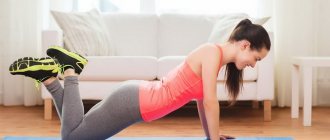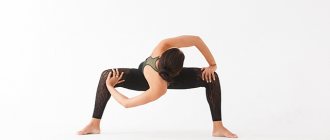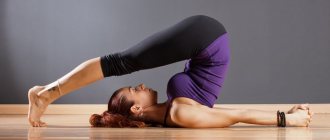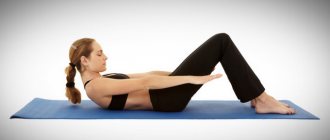Yoga in hammocks was developed in the USA and includes a set of effective exercises to stabilize the body, relieve tension, improve blood circulation, restore metabolic processes and rejuvenate. Yoga techniques are divided into 3 subtypes (classical aerial yoga, fly yoga, anti-gravity Pilates). It is necessary to master a set of exercises step by step, taking into account the recommendations of specialists and health restrictions.
What's special?
Yoga in the air on ribbons and canvases was invented by choreographer K. Harrison. A hammock was included by a specialist in a set of exercises, then the Fly Yoga system was formed. Complex asanas are performed in a suspended position.
Supporting sheets are made from durable fabrics that can withstand weights of up to 160-200 kg. Hammocks are suspended from the ceiling on ropes. The canvases are a supporting device and relieve stress, reducing tension in the spine when performing techniques. Hammocks allow beginners to perform complex elements (headstands, stretches) in their first lessons.
In addition to classical yoga, the complex includes exercises from Pilates, acrobatic and health-improving gymnastics. More than 3,000 positions and asanas have been adapted for execution on canvases. Exercises can be complicated for experienced athletes or simplified. The techniques can be combined with other types of sports exercises. The disadvantage of yoga on canvases is the need for special equipment; without training, the technique is difficult to perform at home. At the initial stage, instruction from experienced trainers is required.
The techniques are suitable for different age categories (both for children 7-8 years old and for pensioners). In this case, the loads must be adjusted in accordance with the characteristics of the body and the level of preparedness. Older people should master the techniques gradually and with little effort. Classes for children are held in special groups; exercises help improve the growth process, straighten posture, and stabilize hormonal levels.
In the absence of contraindications, the exercises can be performed by pregnant women during short periods. Special techniques allow you to train muscles, improve the functioning of blood vessels and lungs. The canvases in the group are placed below the standard position above the floor. The load falls on the legs and arms, the abdominal area is relaxed. Stretching the hip muscles improves fetal development. A set of exercises helps reduce stress on the legs.
Classes for adults differ in the intensity of exercises in accordance with the level of training. Some combinations include cardio exercises, complex asanas that require extensive yoga experience. Exercises are useful for people suffering from vegetative-vascular disease, working at a computer, or leading a sedentary lifestyle. Recommended techniques during the recovery period after illness and surgery.
What is the essence of the practice
Dynamic yoga is not usually understood as any separate system of practices. It is a set of exercises from various classical styles that should be performed at a fairly fast pace.
This approach allows you to relax perfectly, get rid of any negative emotions and throw out energy.
In general, any classical yoga can be transformed into dynamic yoga: raja, hatha, jnana and others. But initially, more intense practices included strength (Ashtanga Vinyasa) and Kriya yoga. In the first case, a quick change of asanas is implied, in the second - dynamic performance of various poses.
In essence, dynamic yoga involves performing classical asanas at a fairly intense pace. And they connect with each other using special complexes - vinyasas.
In addition, asanas can be successfully combined with the following exercises:
- pranayama (breathing);
- bandhas (energy locks);
- dhyanas (meditations);
- drishtami (concentration of attention).
This original approach allows for an inextricable connection between active movements and balanced breathing. And achieve a state of meditation directly in the process of performing various asanas.
And as a result of regular training, you will be able to reveal your spiritual, physical and energetic potential.
The benefits of aerial yoga
The advantages of regular classes in a new direction of yoga:
- straightening and healing the spine, aligning posture;
- increasing the safety of performing stretching exercises;
- reducing tension in the neck, lower back, pelvic area, back;
- increasing muscle elasticity;
- giving the body plasticity;
- improving blood circulation in the brain, increasing concentration, improving memory;
- stabilization of metabolic processes, removal of toxic substances;
- harmonization of the nervous system, relieving symptoms of stress, stabilizing sleep;
- developing a sense of balance, improving body control skills when performing complex exercises;
- improving blood circulation, stabilizing the cardiovascular system;
- harmonization of the digestive system;
- slowing down the aging process of the body;
- development of body plasticity and flexibility;
- elimination of painful sensations in the back, neck, lower back;
- strengthening body muscles, increasing body tone;
- development of endurance, strengthening of the muscular frame;
- harmonization of mood, creation of a positive attitude;
- improvement of complexion, cell renewal, body rejuvenation;
- stabilization of hormonal levels;
- increased joint mobility;
- stabilization of the vestibular apparatus;
- reduced load on the legs, no risk of developing varicose veins;
- weight loss.
The advantage of this sport is the presence of special turns (decompression), which are done upside down. When hanging in asanas, the spinal column is stretched and lengthened, tension and pain in the back and lower back go away.
The mobility of the spinal discs is restored and posture is straightened. By improving blood circulation, performance improves, the body is cleansed of waste and toxins, cells are renewed and saturated with useful microelements.
Inversions in acroyoga help reduce swelling. By regularly performing inverted asanas, cell renewal processes in the body are accelerated. Additionally, posture is leveled, so height can increase by 1-1.5 cm. Students learn the skills of feeling the body and maintaining balance in complex asanas.
A set of exercises on canvases is suitable for weight loss programs. The techniques help stabilize metabolic processes in the body, speed up metabolism and increase the rate of calorie burning. The average calorie reduction per 1 hour of exercise is 600-650 kcal. The process of burning fat deposits, which begins during training, continues for 24 hours. By adjusting your diet and eliminating high-calorie foods and reducing the amount of carbohydrates in your daily diet, rapid weight loss is possible.
Dynamic yoga
Classic, leisurely yoga asanas that relax the body and calm the mind are not suitable for everyone. For some, a more intense practice that loads the muscles, called dynamic yoga, is acceptable.
What is dynamic yoga?
Dynamic yoga is not a separate system of practices. This is a fast-paced class of classical yoga, which gives you the opportunity to release the accumulated energy in the body and then relax it. The best analogy is dynamic meditation - a surge of emotions and physical activity allows you to dive deeper into yourself.
Dynamic yoga also has nothing to do with fitness. At its core, it is the performance of classical yoga asanas in a certain rhythm and sequence, connected by vinyasas - special sets of movements. A striking example of such a sequence is “Salutation to the Sun” (Surya Namaskar) and “Salutation to the Moon” (Chandra Namaskar). In yoga practice, vinyasa symbolizes the inextricable connection between movement and breathing. The yogis of antiquity bequeathed: “Do not perform asana without vinyasa!” Otherwise, concentration will be lost, which means that the deep benefits inherent in yogic exercises will not be revealed. Vinyasa allows the practitioner to experience a state of meditation in action. In dynamic yoga, asanas interspersed with vinyasas can be combined with a system of breathing exercises (pranayama), energy locks (bandhas), concentration (drishti) and meditation (dhyana).
In general, any of the classical types of yoga can be transformed into dynamic. However, initially, Ashtanga Vinyasa yoga (so-called power yoga), in which asanas quickly replace each other, and Kriya yoga, in which each pose is performed dynamically, was always considered more intense.
The benefits of dynamic yoga
Thanks to the fast rhythm during dynamic yoga classes, the joints and muscles of the body are deeply worked out, the musculoskeletal system and the cardiovascular system are strengthened. The fast pace of performing asanas increases the circulation of fluids and energies in the body. As a result, the body is not only cleansed of everything unnecessary, but also rejuvenated at the cellular level. Regular practice of dynamic yoga allows you to keep the muscles of the body in good shape, and the duration of training helps to balance the physiological processes in the body. By performing asanas at a fast pace, complementing them with pranayamas and bandhas, a person can free himself from energy blocks and psychological traumas that make muscles and joints less mobile. Dynamic yoga eliminates the effects of stress, treats depression, calms the mind, gives a great mood and a feeling of lightness in the body.
Beginner yogis may have some difficulties in a dynamic yoga class, but this does not mean that it is not suitable for beginners. It is enough to master the basic hatha yoga asanas by attending one or two classes for beginners in order to continue performing them at a dynamic pace. Having confidently performed classical yoga asanas, you can begin their dynamic combinations. This will not only add variety to your daily yoga practice, but will also further strengthen your skills.
Dynamic yoga for weight loss
Some practitioners choose dynamic yoga in hopes of losing weight or sculpting their body shape. Thanks to the intense pace of classes, dynamic yoga is great for weight loss. The undeniable advantage of dynamic yoga is the short duration of classes. In just ten minutes you can work out the main muscle groups, strengthen your arms, back, and abs. This will not only benefit your figure, but will also have a positive effect on the entire body.
After working out at a fast pace for a quarter of an hour, you can give your body a break by mastering several pranayamas that can balance your energy. Dynamic performance of asanas warms up the body well, so you can practice this yoga in the fresh air without fear of freezing. And to avoid sweating too much, you can wear thermal underwear.
Dynamic yoga - practice in the flow
While practicing dynamic yoga, remember that asanas are an effective tool through which our body not only takes on a new shape, but also goes beyond its physical limitations. This is a powerful method of self-improvement that symbolizes our spiritual path.
Let the movements of your body become an object of contemplation. Move quickly but smoothly, as if flowing from one pose to another. Try to synchronize your movements with your breathing. It is breathing in yoga that is that peculiar thread that connects each of the asanas with each other. Time after time, the coordination of your movements will increase, they will become more accurate and confident. You will have additional energy for new achievements, your body will become flexible and strong, and harmony and peace will settle inside.
Author: Zhanna Shishkova
Contraindications
Contraindications for practicing on canvases include damage to the musculoskeletal system and the recovery period after surgery. In some cases, exercises are contraindicated during pregnancy (long term), changes in blood pressure (low, high), and within 4-5 days after Botox injections. Exercises are not recommended for overwork, colds, or fever.
To perform inverted asanas, you need to wait 3 hours after eating. Avoid training during periods of menstruation. If dizziness, nausea, rapid heartbeat, or arrhythmia occur, continuing to exercise may be harmful.
In addition to temporary restrictions, it is prohibited to perform exercises for the following diseases:
- phlebeurysm;
- thrombophlebitis;
- weakened blood vessels of the eyeball;
- brain thrombosis;
- hypertension;
- atherosclerosis;
- heavy physical labor before training;
- disruptions in the hormonal system (thyroid disease);
- vertebral displacement;
- glaucoma;
- diseases of the circulatory system and heart;
- presence of spinal and cervical injuries;
- intervertebral hernia.
Experts recommend that if you have health problems, undergo an examination and receive recommendations from your doctor to prevent possible injuries. In case of exacerbation of diseases, it is important to cancel exercises; techniques are not performed when taking a large number of medications in the postoperative period, or when restoring the body after injuries. Classes take place 6-8 hours before going to the sauna; you need to wait 4 hours after the steam room before training.
How is the lesson going?
A standard lesson for beginners takes 1-1.5 hours. For training, you need clothing that fits close to the body and does not restrict movement. It is optimal to wear leggings and a top made of elastic fabric. No shoes are required when performing the exercises. Long curls must be removed with a hairpin. Jewelry is removed before classes to safely perform the techniques.
The load for students is selected by a specialist, taking into account the characteristics of physical fitness and health status. The specialist prepares a hammock to suit the students’ parameters. It is necessary to warm up the body, adjust breathing, and consistently increase the load on muscles and joints. Head turns and body bends are optimal.
Exercises on canvases begin with simple asanas on the floor. The weight is then transferred to the hammock. In a series of simple techniques, you can touch the floor with your foot. Then the body is lifted from the surface and asanas are performed only in the air.
It is recommended to start with small turns, limiting the time spent upside down. The complexity of the exercises and the duration of the training are consistently increasing. To get the effect of training, it is important to relax the body in asanas. After completing the main part of the training, relaxation techniques and breathing stabilization are performed. The class ends with the “Shavasana” pose.
Dynamic yoga: a set of morning and evening exercises
Yoga in the full sense of the word is a philosophy and way of life aimed at physical and spiritual improvement. When studying yoga, traditionally, primary attention is paid to its static components - breathing, asanas, meditation. At the same time, dynamic yoga, or kriya yoga, is an integral part of yoga practices. Its main variety, Ashtanga yoga, is a system of unlocking physical, spiritual and psychological potential through the interconnection of breathing, postures and concentration (pranayama, asanas and drishti) and progress in the main eight directions of yoga (morality, self-improvement, postures, breathing, thoughts, concentration, meditation and complete balance).
The basis of dynamic yoga is a change of asanas and bandhas (energy locks), interconnected by vinyasas (transitions) and balanced breathing. The most famous dynamic yoga exercises are Sun Salutation (Surya Namaskar) and Moon Salutation (Chandra Namaskar).
The widespread Surya Namaskar complex consists of 12 asanas, during which one inhales while bending and exhales while bending. Stand with your eyes closed and relaxed, feet together, palms at chest level, mentally greet the sun. Inhale, raise your arms with your palms forward, bend over, focus on your spine and bend over, trying to place your palms on the floor, press your head to your knees without bending them. Palms remain on the floor, left knee bent, right leg extended back, back and arms straight, gaze directed upward, focus on the point between the eyebrows. As you exhale, the left leg moves back to the right, the pelvis rises, look at the knees, focus on the neck. After exhaling while holding, place your knees on the floor, touch the floor with your chest and chin, focus on your back muscles, move your body forward and straighten your arms, lower your hips to the floor, bend over and throw back your head, and inhale. Raise your pelvis again and lower your head, exhale. As you inhale, move your left foot between your hands, straighten your back, and raise your head. Move your right foot to your left, bend, exhale. Raise your arms, bend over, inhale and exhale, folding your palms in front of your chest. This complex is performed in the morning, looking at the sun or standing towards it; it stimulates all muscles and internal organs, fills the body with energy, and clears consciousness.
Chandra Namaskar has a relaxing and calming effect, especially recommended for women. Its 14 asanas correspond to the main phases of the moon. This complex is performed in the dark, preferably the presence of the Moon in the sky or visualization of its image. They start with a greeting pose - palms folded in front of the chest, then inhale with a bend and arms raised above the head, and bend as you exhale. With your palms on the floor, move your right leg back, placing your knee on the floor, straighten your body, fold your palms in front of your chest, move your arms up and back, lift your chin and look up, focusing on the bridge of your nose. Place your palms on the floor, move your left leg back, rest on your toes, raise your pelvis and lower your head. Bend your knees and elbows, touch the floor with your chest and chin. Move your body forward, straighten your arms and bend over, lower your head again and raise your pelvis. Bend your knees, sit on your heels, touch the floor with your forehead, straighten your knees again, raise your pelvis and lower your head, resting on your toes and palms. Move your right foot forward, bend your left knee, fold your palms, raise your arms up and back, look up. Place your palms on the floor, move your left foot towards your right, straighten your legs, tilt your body and head. Straighten up, bend over, move your arms straight up and back, then fold them in front of your chest.
Performing asanas in motion allows you to activate the deep processes of the body, get rid of tightness in muscles and joints, and at the same time increase the flexibility and mobility of consciousness.
Varieties of aerial yoga
3 types of yoga in hammocks have been developed:
- classical exercises;
- fly yoga to restore the body;
- anti-gravity yoga.
The classical direction combines exercises from aerial gymnastics and yoga. Asanas, relaxation techniques, and the body’s mood for relaxation or concentration are used. With regular exercise, the functioning of the nervous system is stabilized and the body's endurance increases.
The anti-gravity direction combines Pilates and aerial yoga techniques. The techniques will help students strengthen and form a beautiful muscle profile, straighten and improve the spine, give grace to the figure, and reduce excess weight. A type of acroyoga helps improve stretching, increase body flexibility, tone muscles, and strengthen the body. Special techniques help develop a sense of balance, relax, and reduce tension in the body. After classes there is no feeling of fatigue, because the complex is built by combining loads and relaxation.
The restorative set of exercises on canvases (fly yoga) combines simple techniques. The direction is based on stretching that has a positive effect on the hip joints, spinal column, and connective tissues.
The complex is often recommended if there are restrictions for intense training and during recovery after surgery or injury. Complex asanas are easier to perform on fixed surfaces, and the load on the body is reduced. Training allows you to increase joint mobility, perform complex stretches and even do the splits.
The techniques for performing the elements also differ depending on the type of hammocks suspended from the ceiling on ropes. There are 2 types of canvases for performing exercises in the air:
- canvas folded in 2 layers;
- hammock with additional devices (handles, inserts, stirrups for fixing hands, etc.).
A set of yoga exercises in hammocks
Yoga in hammocks, the video of which is attached to this article, can include a wide variety of exercises aimed at:
- improvement of lymph and blood circulation, stimulation of venous outflow;
- relieving tension from the back muscles, especially the lumbar region;
- removing clamps from the cervical spine;
- posture correction;
- increasing body flexibility;
- improving the cardiovascular and respiratory systems, as well as improving coordination of movements.
Master class “yoga in hammocks” (entry level):
Yoga complex in hammocks for spinal traction:
Complex to music (spinal and joint stretching):
A wonderful set of aerial yoga accompanied by music. Excellent stretching and relaxation:
Set of exercises
The lesson begins with a warm-up consisting of simple exercises:
- You need to stand on the floor, take the edges of the panels and gently sway along with the hammock, maintaining your balance.
- You need to put your foot on the canvas, the other foot should rest on the floor. In the pose you need to sway smoothly.
- You need to press your back against the hammock and, holding on with your hands, gently sway.
- A handstand is performed with the pelvic region in a fixed position in a hammock.
- Deflections on the canvas help eliminate stress on the lower back and cervical vertebrae and simplify the performance of complex techniques.
The standard exercise program for beginners includes a set of asanas such as:
- Adho Mukha Svanasana;
- Baddha konsana;
- Paschimottanasana;
- Chakrasana;
- Halasana;
- Sirsasana.
Classic pose Adho Mukha Svanasana (“downward facing dog”). A pose supported by a hammock improves blood circulation, enhances blood circulation in the brain, helps launch cell renewal processes, and evens out facial tone. The functioning of the digestive system improves, intestinal activity is normalized, and the ankle areas and other muscles are stretched.
Performing asanas on canvas differs from the classical version by the ability to stretch the spine along its entire length and reduce the load on the intervertebral discs. In the classic exercise, it is more difficult to completely straighten your back in the asana. With the help of cloths, even beginners can stretch the spine, relax the neck, and reduce the load on the cervical vertebrae.
Asana Baddha Konsana (Bound Angle Pose) has a beneficial effect on the pelvic area, lumbar region, abdomen, and genitourinary system. Regular exercise helps reduce pain during menstruation, harmonizes the functioning of the hormonal system of women, the functioning of the uterus and ovaries. The asana can be performed during pregnancy if there are no contraindications. The technique involves spreading the hips to the sides and connecting the feet. The technique allows you to gently stretch muscles and joints even without lengthy preparation, since the fabrics reduce the load.
Paschimottanasana asana is designed to gently stretch the back of the body. The technique allows you to reduce back pain, relax your neck, and straighten your back.
When performing the pose on the floor, students focus on straightening their legs. When using canvases, the legs in the asana are held in place by fastenings, so all attention is paid to straightening the back and creating the correct position of the shoulders.
Chakrasana asana is adapted for performing in the air . Exercise helps straighten your back, eliminate stoop, and strengthens the muscles of your legs and arms. Performing asana allows you to increase your energy level and increases blood flow to the cells of the body. Experts recommend starting to learn the technique after mastering simple exercises.
The legs and arms must be trained to support the body weight. The asana is not suitable for those who have problems with the lumbar region. When using a hammock, the lower back and pelvis are fixed on a plastic fabric that gently supports the back. Before performing the technique, stretching is required; the loads are increased gradually.
Asana Halasana helps to develop flexibility and plasticity of the vertebral sections, improve the functioning of the digestive organs, and balance hormonal levels. With a rush of blood to the head, brain functions are activated, concentration increases, memory improves, and the speed of thought processes increases.
However, it is necessary to master the technique on the floor gradually, since the upper spinal region is involved when performing the exercise.
Shirshasana asana (headstand) harmonizes the state of the nervous system, improves vision, concentration, and stabilizes the functioning of the digestive system. When performed regularly, the level of hemoglobin in the blood increases. It is important to take into account contraindications for performing an inverted asana. The use of the equipment is prohibited for people with heart and vascular diseases, hypertension, chronic inflammation of the ears, eyes, or displacement of the vertebrae.
It is not recommended to perform the exercise without preparation and after a long break in practice (1 year).
Complex aerial exercises must be mastered under the guidance of an experienced instructor. In the future, it is possible to independently improve the techniques.
Yoga in hammocks – reviews
Many people around the world have already been captivated by yoga in hammocks; Their reviews indicate that this sport allows you to improve your well-being, find harmony with yourself and with the outside world, and become a more self-confident person. This is an excellent way to maintain good physical shape, lose weight, get rid of chronic joint pain and back pain, as well as manifestations of varicose veins.
Anti-gravity classes give you the opportunity to experience new sensations, recharge with positive emotions and feel lightness throughout your body, forgetting about the burden of everyday worries!
I would like to separately note that yoga in hammocks is a love for life. It is not suitable for many because of possible dizziness from hanging upside down (although it will get better after 2-3 sessions). Many people are afraid of heights or that they won’t succeed. But if you made up your mind, if you overcame your fears and worries, if you were able to survive the fact that the next day, out of habit, something might ache, then you will not regret it. Wonderful deep and soft stretching, improved condition of the spine, improved blood circulation in the brain, healthy moving joints, weight loss (this activity cannot be called easy relaxation), a wonderful social circle (people who go to yoga are still a little special) and so on! (Alexandra Virii).
I do yoga in hammocks with great pleasure. For me, hanging upside down is a salvation from neck and back problems. (Ieif).
Reviews
Oksana, 40 years old, Moscow : “The doctor recommended doing yoga exercises in hammocks to reduce back pain. I have been training regularly with an instructor for about 1 year. The load on the spine and joints is reduced, but it is important to increase the complexity of the techniques gradually. Flexibility and plasticity have appeared; regular practices improve well-being, stabilize hormonal levels and increase the body’s resistance to disease.”
Elena, 29 years old, Krasnodar : “I’ve been doing classical yoga for about 2 years and decided to try techniques performed with the help of hammocks. The advantage of the canvas is that it stretches the spine and reduces stress on the neck. The elasticity of muscles has improved, the functioning of the nervous system has stabilized. Regular physical activity increased the plasticity of the body and helped reduce weight by 3-4 kg. I’m satisfied with the result.”
Ekaterina, 33 years old, Kaliningrad : “I work at the computer, my back gets tired.
Exercises help relieve tension in the neck and back, increase the body’s endurance, and improve concentration.”
What do aero or anti-gravity tricks do?
Anti-gravity yoga in hammocks suspended from the ceiling is also carried out in the fresh air, where the support for the hammocks is already stretched ropes between trees, rocks, and special rods. Aerial yoga helps you gain superpowers:
- Healthy spine. With the help of yoga in hammocks, get rid of aches and fatigue, and completely unload the spine.
- Plastic like a cheetah. Various backbends, asanas and other exercises will improve coordination and agility. Now you are able to control your body!
- Strengthening joints. Aerial tricks in a hammock will prevent the vessels from aging. With the help of special training, the range of motion of the joints is restored.
- Phenomenal memory. Exercises in a hammock are an effective procedure for increasing concentration, clarity of mind and memory, the ability to always make the right decisions, and overcome fear, phobias, and self-doubt.
- Relaxing in hammocks is like a drug. Aero yoga classes develop the habit of a good mood and euphoria. Any pose perfectly stimulates the pituitary gland, “releasing” the hormones of happiness: serotonin, dopamine and a dose of adrenaline.
Aerial yoga is needed to stretch the spine and strengthen muscles
Fly yoga classes are held both indoors and outdoors.
Aerial yoga poses make you feel like a happy and healthy person. Plunge back into childhood memories when you carefreely enjoyed the little things: flying on a swing or riding a bike down a slide. For adults, the shavasana exercise in a swinging hammock will charge you with carelessness, calmness and joy.
Yoga, Pilates, stretch - these are some of the Antigravity programs










